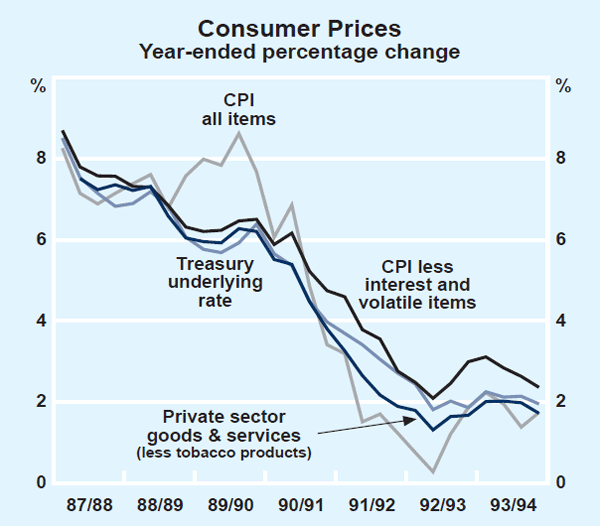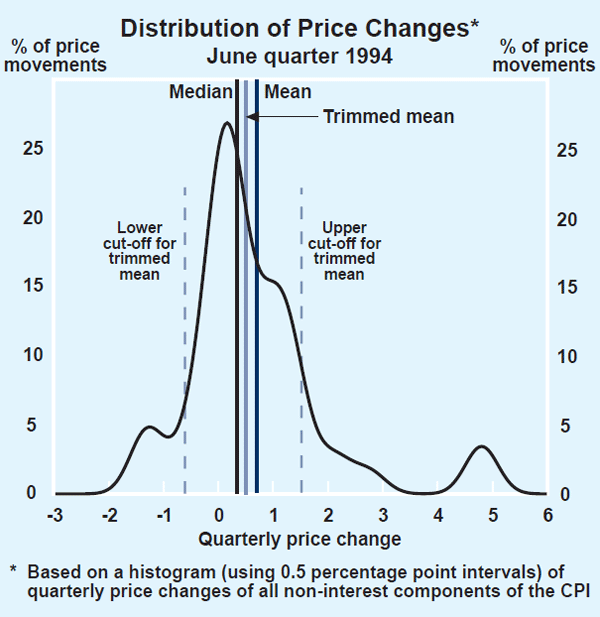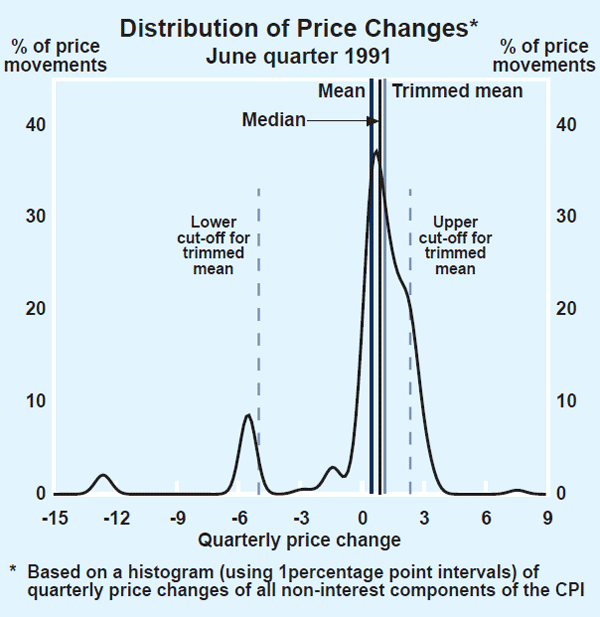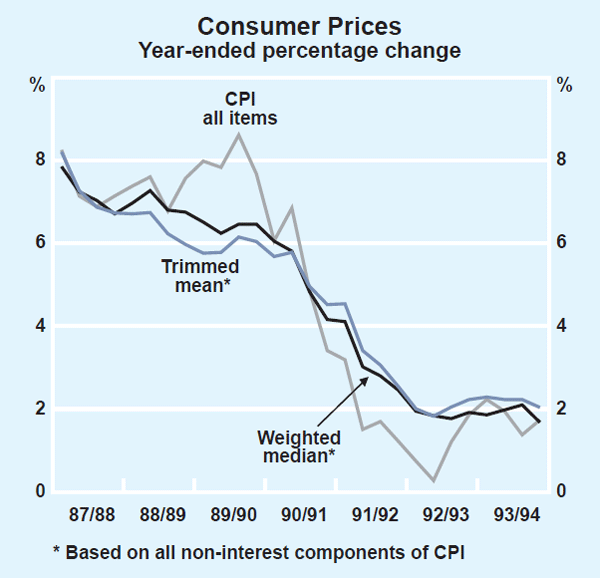Bulletin – August 1994 Measuring ‘Underlying’ Inflation
- Download 268KB
The most commonly-used measure of price movements is the Consumer Price Index (CPI). It captures the broad characteristics of inflationary performance over the long term, but has drawbacks over a shorter horizon, particularly for monetary policy purposes:
- it is often subject to large temporary influences, such as adverse climatic conditions, which cause temporary variations in the prices of fruit and vegetables;
- it is influenced by factors such as changes in taxes, government charges and interest rates which, while they affect the cost of living, do not directly reflect the underlying inflationary pressures in the economy.
In formulating monetary policy, it makes sense to try to abstract from these factors and focus on the ‘underlying’ inflation rate. This article discusses some of the conceptual issues involved in deriving measures of ‘underlying’ inflation. It then examines a range of alternative measures of underlying inflation for Australia and discusses some of their characteristics. All the measures are based on the CPI. The implicit price deflators from the national accounts, which are also useful as measures of underlying inflation, are not considered here. CPI-based series are more timely, and hence usually receive more attention.
Underlying Inflation: Conceptual Issues
Ideally, an underlying measure of inflation for monetary policy purposes should capture the trend in the general price level which reflects the balance between aggregate demand and supply in the economy. To this end, the effects of changes in interest rates, which can have a direct and significant impact on movements in the CPI, are invariably excluded. While their inclusion is appropriate when the CPI is viewed as a cost-of-living index, it is clearly inappropriate for interest charges to be included in a measure of inflation which is itself an objective of monetary policy.[1]
In addition, underlying measures of inflation usually abstract from the effects of price changes for items such as fresh fruit and vegetables, and petrol, which can fluctuate widely from quarter to quarter. Price changes driven by changes in government charges and taxes are also often excluded.
A case can be made for abstracting from the impact effects on the CPI of shocks (such as major changes in oil prices or in the exchange rate) which result in a once-off shift in the price level, rather than a change in the rate of growth of the price level. In practice, however, distinguishing these once-off movements in the price level from on-going changes in the underlying rate of inflation is not straightforward. Some price changes include elements of both factors. A ‘once-off’ change in the price level – for example, because of a tax or exchange rate change – may also have a lasting effect on the underlying inflation rate, depending on its effect on inflationary expectations, and on whether price and wage setters in the domestic economy attempt to restore the previous relativities. The actual and anticipated response of monetary policy to these factors is also important.
It follows from the foregoing that there is no single statistical series which is always and everywhere a good guide to ‘underlying inflation’. Several series can be constructed, which may be useful in a range of circumstances, but none removes the need for an element of judgment in assessing inflationary trends. Some measures are outlined below.
Existing Measures of ‘Underlying’ Inflation
The most common approach to measuring underlying inflation is to exclude nominated items from the CPI basket. Typically, the excluded components are those which are volatile and/or seasonal, those which are subject to administrative price setting (e.g. government goods and services), and those components which are sensitive to interest rates. There are several widely-used measures; Graph 1 shows the composition of three commonly-used series.

-
The CPI net of interest and ‘volatile items’
This measure removes both mortgage and consumer debt interest charges from the CPI on conceptual grounds, along with the prices of fresh fruit and vegetables and petrol on volatility grounds. It retains about 85 per cent of the CPI basket, but is still affected by changes in public-sector prices and indirect taxes. - Prices for privately-provided goods and services
This measure, which the Bank introduced in 1992,[2] focuses on those prices which are determined in the market sector of the economy. In addition to the items in (i) above, it also excludes prices for goods and services provided mostly by the public sector – for example, urban transport fares, health services, and State and local government rates and charges. It covers just under 70 per cent of the total CPI basket. -
Treasury ‘Underlying Inflation’ series
This measure has been compiled by the Federal Treasury for many years. In addition to the items excluded under (i) and (ii), it also excludes other items that are susceptible to price volatility, such as meat and seafoods, and tobacco and alcohol, and some items that have a seasonal pattern, such as holiday travel and accommodation and clothing. It retains about 50 per cent of the CPI basket.
Some of these measures can still be affected by ‘once-off’ factors. In the past two years, for example, increases in taxes on tobacco have added substantially to the measure of private sector prices (tobacco products are usually included in that measure because they are produced and sold by the private sector). For this reason the Bank has excluded tobacco products when assessing underlying inflation over the past couple of years. When this is done, the underlying annual inflation rate appears to have been at around 2 per cent since the middle of 1992, similar to the reading given by the Treasury series (see Graph 2).

Each of these underlying measures is also affected, to varying degrees, by the rise in wholesale sales taxes across the board in the 1993/94 Budget and the depreciation of the exchange rate through 1993. Neither of these effects can be gauged directly from the CPI data and so cannot be easily excluded.
The major conceptual difficulty with all the above measures is that the decision about which components to exclude is somewhat arbitrary, and influenced by events in particular periods. The practice of excluding petrol, for example, arose during the OPEC oil price shocks of the 1970s. Moreover, by excluding particular components all the time, all information contained in those components – including that attributable to genuine underlying inflationary forces – is lost. This information may well be relevant in periods when the components are not particularly volatile.
Additional Measures of Underlying Inflation
Alternative measures of underlying inflation can be constructed which do not rely as heavily on judgments about which prices to exclude; rather, they rely on excluding all extreme movements – from whatever source. Two measures which have received some attention recently are the ‘trimmed mean’ and ‘weighted median’ inflation rates.[3]
These two measures give less weight to ‘outliers’ – that is, very large rises or falls in a particular price or set of prices – than do standard average indexes of inflation, without permanently excluding prices for those particular items. They include all components of the CPI, along with their appropriate weights, in their calculation, with the exception of interest charges, which are excluded for the reasons mentioned earlier. The rest of the price movements for the various items are then ranked by size of price movement and weighted by their importance in the CPI regimen. From this array of price movements, the two measures of underlying inflation can be calculated. The calculations are shown in a stylised way in Graphs 3 and 4, based upon CPI data for the June quarters of 1994 and 1991, respectively.[4]


- The trimmed mean inflation rate involves calculating the weighted mean of price movements in the central core of the whole array – in effect, cutting off the ‘tails’ of the distribution. The choice of the size of the central core is arbitrary; in the examples presented here, the central 70 per cent of the distribution each quarter has been chosen. The items cut out in this process will often consist of those ‘volatile’ elements excluded in deriving the underlying measures examined earlier. For example, price changes for fresh fruit and vegetables were recorded in the most extreme parts of the distribution in 59 of the past 70 quarters; however, this will not always be so. The key feature of this measure is that extreme movements in any item are disregarded, while small movements in usually volatile items will remain in. In the recent June quarter, for example, the price of automotive fuel was among the items excluded in the upper tail, along with vehicle insurance, wine and recreational goods. On the other hand, fresh fruit and vegetable prices, which rose by 0.3 per cent in the quarter, clearly remained in the core of the distribution.
- The weighted median inflation rate is the inflation rate for that item or group of items which is in the middle of the total distribution – that is, half the weighted price changes are on one side of the median, and half on the other.
Where the underlying distribution of price changes is broadly symmetric (with the (weighted) number of prices showing a rise larger than the mean approximately the same as that showing a rise less than the mean), the trimmed mean and median inflation rates will be about the same as the published CPI net of interest charges. On the other hand, where the distribution of price rises is ‘skewed’ (with a number of items exhibiting particularly large increases or decreases in a quarter), the median and the trimmed mean inflation rates will lie, respectively, below or above the CPI. In the case of the negatively ‘skewed’ distribution shown for the June quarter of 1991 in Graph 4, the median and trimmed mean statistics were less affected than the published CPI change by a fall in the prices of fresh fruit and vegetables, holiday travel and accommodation, petrol and a few other small items.
As Graph 5 shows, both the median and trimmed mean inflation rates are suggestive of underlying inflation of around 2 per cent over recent years.[5] Both these measures are shown in Table 1; this table will be updated regularly in the Bulletin, appearing as Table G.1.

| Consumer price index | Private consumption deflator | Other consumer price measures | |||||||||
|---|---|---|---|---|---|---|---|---|---|---|---|
| Private sector prices | |||||||||||
|
All groups |
Excluding interest rates and volatile items (a) |
Goods (b) |
Services (c) |
Total (d) |
Treasury underlying rate (e) |
Implicit price deflator (f) |
Fixed- weight index |
Weighted median (g) |
Trimmed mean (h) |
||
| Quarterly percentage change | |||||||||||
| 1989/90 | |||||||||||
| Jun | 1.6 | 1.4 | 1.5 | 1.7 | 1.6 | 1.6 | 1.5 | 1.4 | 1.6 | 1.4 | |
| 1990/91 | |||||||||||
| Sep | 0.8 | 0.9 | 0.7 | 1.3 | 0.8 | 0.8 | 0.9 | 1.0 | 1.1 | 1.0 | |
| Dec | 2.6 | 2.0 | 1.4 | 2.7 | 1.8 | 1.3 | 2.1 | 2.4 | 1.5 | 1.9 | |
| Mar | −0.2 | 0.7 | 0.7 | 0.0 | 0.5 | 0.7 | 0.4 | 0.2 | 0.6 | 0.6 | |
| Jun | 0.2 | 1.0 | 1.3 | −0.1 | 1.0 | 1.1 | 0.5 | 0.3 | 0.9 | 1.0 | |
| 1991/92 | |||||||||||
| Sep | 0.6 | 0.7 | 0.5 | 0.2 | 0.4 | 0.5 | 0.6 | 0.8 | 1.0 | 1.0 | |
| Dec | 0.9 | 1.3 | 0.8 | 1.8 | 1.0 | 1.1 | 0.6 | 0.8 | 0.5 | 0.8 | |
| Mar | 0.0 | 0.5 | 0.2 | −0.6 | 0.0 | 0.3 | 0.5 | 0.2 | 0.4 | 0.3 | |
| Jun | −0.3 | 0.2 | 0.8 | 0.1 | 0.6 | 0.7 | 0.3 | 0.3 | 0.6 | 0.5 | |
| 1992/93 | |||||||||||
| Sep | 0.1 | 0.5 | 0.5 | 0.4 | 0.5 | 0.3 | 0.3 | 0.6 | 0.5 | 0.4 | |
| Dec | 0.5 | 0.9 | 0.9 | 0.5 | 0.8 | 0.4 | 0.5 | 0.6 | 0.3 | 0.6 | |
| Mar | 0.9 | 0.9 | 0.7 | −0.3 | 0.5 | 0.6 | 0.8 | 0.7 | 0.3 | 0.5 | |
| Jun | 0.4 | 0.7 | 0.8 | 0.4 | 0.7 | 0.6 | 0.3 | 0.3 | 0.8 | 0.7 | |
| 1993/94 | |||||||||||
| Sep | 0.5 | 0.6 | 0.8 | 0.3 | 0.7 | 0.7 | 0.3 | 0.5 | 0.5 | 0.5 | |
| Dec | 0.2 | 0.6 | 0.4 | 1.3 | 0.6 | 0.3 | 0.5 | 0.6 | 0.5 | 0.5 | |
| Mar | 0.4 | 0.7 | 0.5 | 0.0 | 0.4 | 0.6 | 0.2 | 0.0 | 0.4 | 0.5 | |
| Jun | 0.7 | 0.5 | 0.4 | 0.5 | 0.4 | 0.4 | n.a. | n.a. | 0.3 | 0.5 | |
| Year-ended percentage change | |||||||||||
| 1989/90 | |||||||||||
| Jun | 7.7 | 6.5 | 5.8 | 8.3 | 6.4 | 6.4 | 5.9 | 5.9 | 6.5 | 6.0 | |
| 1990/91 | |||||||||||
| Sep | 6.1 | 5.9 | 5.3 | 6.9 | 5.7 | 5.6 | 5.4 | 5.3 | 6.0 | 5.7 | |
| Dec | 6.9 | 6.2 | 5.1 | 7.3 | 5.7 | 5.4 | 6.0 | 6.3 | 5.8 | 5.8 | |
| Mar | 4.9 | 5.2 | 4.4 | 5.8 | 4.7 | 4.5 | 5.0 | 5.1 | 4.8 | 5.0 | |
| Jun | 3.4 | 4.7 | 4.1 | 4.0 | 4.1 | 4.0 | 3.9 | 3.9 | 4.2 | 4.5 | |
| 1991/92 | |||||||||||
| Sep | 3.2 | 4.6 | 3.9 | 2.8 | 3.7 | 3.7 | 3.6 | 3.8 | 4.1 | 4.5 | |
| Dec | 1.5 | 3.8 | 3.2 | 1.9 | 2.9 | 3.4 | 2.0 | 2.2 | 3.0 | 3.4 | |
| Mar | 1.7 | 3.6 | 2.8 | 1.3 | 2.4 | 3.0 | 2.1 | 2.2 | 2.8 | 3.1 | |
| Jun | 1.2 | 2.8 | 2.3 | 1.4 | 2.1 | 2.7 | 1.9 | 2.2 | 2.5 | 2.5 | |
| 1992/93 | |||||||||||
| Sep | 0.8 | 2.5 | 2.3 | 1.7 | 2.2 | 2.4 | 1.6 | 1.9 | 2.0 | 2.0 | |
| Dec | 0.3 | 2.1 | 2.5 | 0.4 | 1.9 | 1.8 | 1.5 | 1.7 | 1.8 | 1.8 | |
| Mar | 1.2 | 2.5 | 3.0 | 0.7 | 2.4 | 2.0 | 1.9 | 2.2 | 1.8 | 2.0 | |
| Jun | 1.9 | 3.0 | 3.0 | 1.0 | 2.5 | 1.9 | 1.8 | 2.2 | 1.9 | 2.2 | |
| 1993/94 | |||||||||||
| Sep | 2.2 | 3.1 | 3.3 | 0.9 | 2.7 | 2.3 | 1.8 | 2.2 | 1.9 | 2.3 | |
| Dec | 1.9 | 2.8 | 2.8 | 1.7 | 2.5 | 2.1 | 1.9 | 2.2 | 2.0 | 2.2 | |
| Mar | 1.4 | 2.6 | 2.6 | 2.0 | 2.4 | 2.1 | 1.3 | 1.4 | 2.1 | 2.2 | |
| Jun | 1.7 | 2.4 | 2.1 | 2.1 | 2.1 | 1.9 | n.a. | n.a. | 1.7 | 2.0 | |
|
For footnotes see ‘Notes to Tables’,Table G.I, page 68. Sources: ABS Cat. Nos 5206.0, 6401.0; Commonwealth Treasury. |
|||||||||||
Conclusion
The ‘underlying’ rate of inflation – rather than the conventional CPI – is the primary focus for monetary policy purposes; it is this concept which the Bank has in mind when it talks of limiting inflation to around 2 to 3 per cent a year on average. There is, however, no single, precise and unambiguous measure of underlying inflation; none of the possible measures fully comes to grips with the problem of distinguishing between once-off changes in the price level and on-going movements in prices. In practice, the best approach is to monitor a variety of measures and reach judgments on the basis of those measures. So far as the recent past is concerned, the best judgment is that the underlying inflation rate has been running at about 2 per cent.
Footnotes
A detailed discussion of the issues surrounding the treatment of interest costs in the CPI can be found in ‘Home Ownership and Interest Charges in the CPI‘, Treasury Economic Round-Up, January 1989. [1]
Reserve Bank of Australia, Bulletin, May 1992. [2]
These measures were discussed recently by Michael Bryan and Stephen Cecchetti in ‘Measuring Core Inflation’, Federal Reserve Bank of Cleveland Working Paper No. 9304, and have been used subsequently by some central banks (see Bank of England, Inflation Report, various issues, and Reserve Bank of New Zealand, Bulletin, June 1994). [3]
The curves in the graphs have been fitted to the actual observations in a smoothed fashion to facilitate exposition; the computations have been carried out on the raw data. [4]
Annual inflation rates for the median and trimmed mean series can be compiled either by cumulating the quarterly median and trimmed mean CPI changes, or by taking the median and trimmed mean of the annual rates of change of the CPI items. These two calculations can give different answers. In Table 1, the former method has been used because this gives a continuous long-run series. Taking the median/trimmed mean of annual changes, however, shows a slightly higher rate of inflation at present, a tendency it has also exhibited at times in the past. [5]